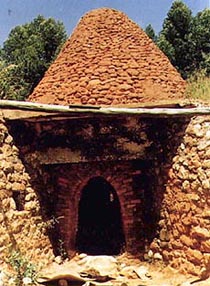

How they used to ..........
Process
wool - Make Paint - Make Salt
Travel - Irrigate - Thresh - Mill
Card and Spin
Wool
These ladies were demonstrating old skills newly learnt at a small exhibition "Fios
de Lar" - 'Threads of the Hearth', in Vila do Bispo.
A course on spinning with a wheel was also underway recently in Odeaxere, but the camera
was not to hand.
| Carding Wool | Hand Spinning |
Made Quicklime
Near these old kilns used to be another, which had been abandoned shortly after its last
firing, complete with conical mud roof. This was demolished to make way for the widening
of the EN125, the laying of water pipes and urbanisation roads.
| Ruins of the Furnas, seen from the EN125. |
|
 |
This is an archive picture of the last
working furnas in the Budens area at Quinta das Furnas. |
Wood was lain for the firing in the bottom, in the square entrances. Above
the brickwork chunks of limestone were piled, and the whole sealed in with a mud roof. The
fire was set and the kiln cooked away for a few days, and then left to go out. The stone
was dehydrated by the heat, and became quicklime. This was anciently used in plague pits,
to dehydrate the bodies and cleanse them, by heat, of disease.
When added to water there is a violent, hot reaction. The resulting liquid is used for
painting the houses, producing the characteristic whitewash. A benefit is that it also
acts as a insecticide. The whitewash can be coloured by the addition of pigments.
Traditionally if blue (cobalt) surrounds the windows and doors, evil spirits are kept
away. Yellow is used to repel ghosts.
| Keeping out evil spirits | Warding off Ghosts |
Salt Pans
There are salt pans still in use alongside the EN125, at the eastern end of the bridge
spanning the River Arade, at Portimão.
This area is dammed off from the river with a sluice gate. At high tide the sluice is
opened, and the sea-water enters the evaporation area. As the water evaporates in the hot
weather, the salt crystallises out. The crystals are collected into mounds, and the cycle
repeated until the glistening mounds are ready to be collected.
Salt has been evaporated in this fashion since Roman times. Salt Pans are sometimes
featured in the Manuelin (early 16th century) style of architecture, such as in this
elaborate window of the Convento do Cristo at Tomar.
|
West Window, Convento do Cristo, Tomar |
Send mail to info@valegrifo.com with questions
or comments about this web site.
Copyright © 1999 Vale Grifo
Last modified: June 04, 2007